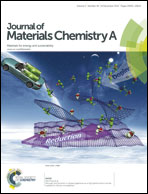Boost up dielectric constant and push down dielectric loss of carbon nanotube/cyanate ester composites via gradient and layered structure design†
Abstract
How to develop high-k materials with extremely low dielectric loss based on commercially available conductors and polymers is still a big challenge. Here we present a general method that simultaneously increases the dielectric constant ten times and decreases the dielectric loss by five orders of magnitude. By adjusting the prepolymerization time of multi-walled carbon nanotube (MWCNT) and cyanate ester (CE) blends and using the layer-by-layer casting procedure, precisely controllable dispersion and distribution of MWCNTs in polymers were achieved. Consequently, a three-layer material (PE-[g-MWCNT0.5/CE-75%]2) with an optimized prepolymerization degree, consisting of two MWCNT/CE composite layers and one polyethylene (PE) thin film, exhibits a dielectric constant of 1027 and a dielectric loss of 0.02 at 1 Hz. This is one of the best results reported for polymer composites made up of nano-carbon or ceramics to date. The mechanism behind this was elucidated by analyzing the polarization of induced charges and transport of free charges. The formation of vastly interconnected networks of space charge regions, and the existence of a conductor fault and an insulating layer are the main factors that determine an extraordinarily high dielectric constant and extremely low dielectric loss simultaneously.


 Please wait while we load your content...
Please wait while we load your content...